Difference between revisions of "Sampling tools for the marine environment"
| Line 4: | Line 4: | ||
Unfortunately, where conflicting conclusions have been drawn patterns in different groups of organisms, it is rarely possible to know whether the patterns truly vary among groups or merely reflect differences in sampling efforts | Unfortunately, where conflicting conclusions have been drawn patterns in different groups of organisms, it is rarely possible to know whether the patterns truly vary among groups or merely reflect differences in sampling efforts | ||
| + | |||
| + | =Sampling tools for pelagic organisms= | ||
| + | ==Midwater or pelagic trawl== | ||
| + | |||
| + | <ref name="maine" >http://www.usm.maine.edu/gulfofmaine-census/Docs/Technology/STPC.htm#bottomtraw</ref>A midwater trawl is a set of gear that is used to catch fish that are between the sea surface and bottom, generally staying clear of the bottom. Occasionally, midwater trawls are configured with floats to perform catching in the shallow-surface layer. | ||
| + | |||
| + | <ref name="fao"> http://www.fao.org/fi/website/FIRetrieveAction.do?dom=geartype&fid=207</ref>A midwater trawl consists of a cone shaped body, normally made of four panels, ending in a codend with lateral wings extending forward from the opening. | ||
| + | |||
| + | <ref name="maine" >http://www.usm.maine.edu/gulfofmaine-census/Docs/Technology/STPC.htm#bottomtraw</ref>Midwater and bottom trawls (see further) have many parts in common, if differing in dimensions and shapes due to their different fishing objects and hydrodynamic regimes of operation. Midwater trawls are designed to catch fish in the midwater column, hence must be capable of rapid maneuvering while maintaining an open net mouth. This is reflected in differences in the body of the net, rigging, and even trawl doors. | ||
| + | [[Image:pelagic trawl1.jpg|left|pelagic trawl <ref name="maine" >http://www.usm.maine.edu/gulfofmaine-census/Docs/Technology/STPC.htm#bottomtraw</ref>|frame]] | ||
| + | [[Image:pelagic trawl2.jpg|right|pelagig trawl <ref name="fao" >http://www.fao.org/fi/website/FIRetrieveAction.do?dom=geartype&fid=207</ref>|frame]] | ||
| + | |||
| + | |||
| + | |||
| + | |||
| + | |||
| + | |||
| + | |||
| + | |||
| + | |||
| + | |||
| + | |||
| + | |||
| + | |||
| + | |||
| + | |||
| + | |||
| + | |||
| + | |||
| + | |||
| + | |||
| + | |||
| + | |||
| + | |||
| + | |||
| + | |||
| + | |||
| + | |||
| + | |||
| + | |||
| + | |||
| + | |||
| + | |||
| + | |||
| + | |||
| + | ==Plankton nets== | ||
| + | |||
| + | [11]Plankton nets are a modification on the standard trawl used to collect planktonic organisms, of nearly any size, intact. Towed by a research vessel, plankton nets have a long funnel shape that allows them to catch differently sized plankton simply by changing the mesh size of the net. At the end of the funnel is a collection cylinder called a cod-end. | ||
| + | |||
| + | ===Ring net=== | ||
| + | The ring net consists of a fine-meshed bag attached at its mouth, or opening, to a metallic | ||
| + | |||
| + | |||
| + | |||
| + | |||
| + | |||
| + | |||
| + | |||
| + | |||
| + | |||
| + | |||
| + | |||
| + | |||
| + | |||
| Line 18: | Line 82: | ||
| − | |||
| − | |||
[[Image:ringnet.jpg|right|ring net<ref name="maine">http://www.usm.maine.edu/gulfofmaine-census/Docs/Technology/STPC.htm#bottomtraw</ref>|frame]] | [[Image:ringnet.jpg|right|ring net<ref name="maine">http://www.usm.maine.edu/gulfofmaine-census/Docs/Technology/STPC.htm#bottomtraw</ref>|frame]] | ||
[[Image:bongo.jpg|right|bongo nets<ref>http://oceanexplorer.noaa.gov/technology/vessels/mcarthur/mcarthur.html</ref>|frame]] | [[Image:bongo.jpg|right|bongo nets<ref>http://oceanexplorer.noaa.gov/technology/vessels/mcarthur/mcarthur.html</ref>|frame]] | ||
Revision as of 13:29, 6 September 2007
[1]All methods of physical capture are inherently selective. Small fish may pass through large-meshed nets; large fish may out-swim trawls; gill nets will catch fish mainly of a certain size range. Fish may react differently to fishing gear with respect to species, size, biological state, environmental conditions including ambient light and the acoustic noise field, among many other factors.
[2]|This is why organisms are subdivided out of practical necessity, in that the sampling approach and sample size that are appropriate for one group are often inappropriate for another. The disparity in appropriate techniques for different sizes of groups of organisms has contributed greatly to the paucity of studies on more than one taxonomic grouping at a given locale.
Unfortunately, where conflicting conclusions have been drawn patterns in different groups of organisms, it is rarely possible to know whether the patterns truly vary among groups or merely reflect differences in sampling efforts
Contents
Sampling tools for pelagic organisms
Midwater or pelagic trawl
[1]A midwater trawl is a set of gear that is used to catch fish that are between the sea surface and bottom, generally staying clear of the bottom. Occasionally, midwater trawls are configured with floats to perform catching in the shallow-surface layer.
[3]A midwater trawl consists of a cone shaped body, normally made of four panels, ending in a codend with lateral wings extending forward from the opening.
[1]Midwater and bottom trawls (see further) have many parts in common, if differing in dimensions and shapes due to their different fishing objects and hydrodynamic regimes of operation. Midwater trawls are designed to catch fish in the midwater column, hence must be capable of rapid maneuvering while maintaining an open net mouth. This is reflected in differences in the body of the net, rigging, and even trawl doors.
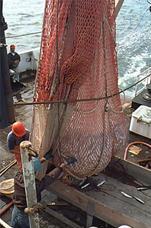
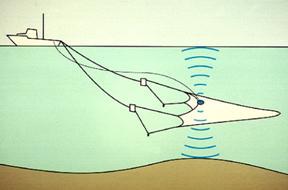
Plankton nets
[11]Plankton nets are a modification on the standard trawl used to collect planktonic organisms, of nearly any size, intact. Towed by a research vessel, plankton nets have a long funnel shape that allows them to catch differently sized plankton simply by changing the mesh size of the net. At the end of the funnel is a collection cylinder called a cod-end.
Ring net
The ring net consists of a fine-meshed bag attached at its mouth, or opening, to a metallic
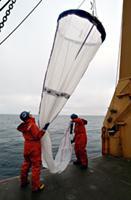
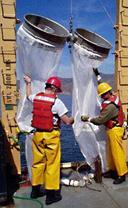
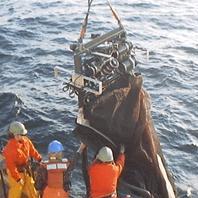

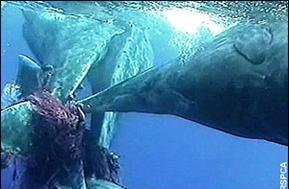
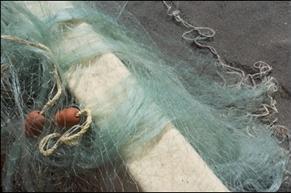
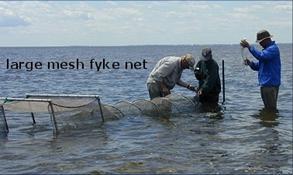
References
- ↑ 1.0 1.1 1.2 1.3 1.4 1.5 http://www.usm.maine.edu/gulfofmaine-census/Docs/Technology/STPC.htm#bottomtraw
- ↑ Steele, J.H.; Thorpe, S.A.; Turekian, K.K. (Ed.). (2001). Encyclopedia of ocean sciences. Academic Press: San Diego, CA (USA). 6 vol. p748-749
- ↑ 3.0 3.1 http://www.fao.org/fi/website/FIRetrieveAction.do?dom=geartype&fid=207 Cite error: Invalid
<ref>tag; name "fao" defined multiple times with different content - ↑ http://oceanexplorer.noaa.gov/technology/vessels/mcarthur/mcarthur.html
- ↑ http://www.dnr.sc.gov/marine/sertc/sampling%20methods.pdf
- ↑ http://www.telegraph.co.uk/news/main.jhtml?xml=/news/2007/04/18/nnet118.xml
- ↑ http://the.honoluluadvertiser.com/dailypix/2006/Jul/23/FPI607230302V2_b
- ↑ http://glei.nrri.umn.edu/default/fykenet.htm